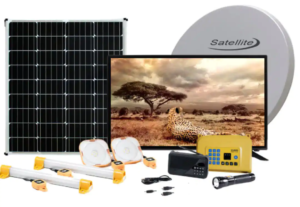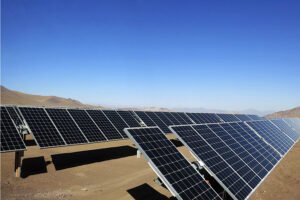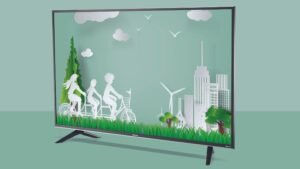Solar powered Televisions have become trendy in today’s world when everyone is talking about sustainability.
In today’s world, our preferred choice for entertainment at home is television. Likewise, I probably watch TV for a few hours every day. So I think that the majority of the population did the same.
Whether we are trying to relax or spend time with our loved ones, it’s easy to spend hours in front of the TV. That’s why television is one of the major energy consumers in our homes, and more electricity consumption can lead to an increase in our electricity bills.
Ultimately, our quality time comes with a hefty electricity bill because TVs also consume a lot of power.
That’s why sometimes I think of using another power source, like solar power for my TV, to cut down on my electricity consumption. But is it possible to do it?
The answer is, yes, with the help of solar panels, not only I but anyone can use the sun’s energy for operating their televisions and other day-to-day appliances like Fridges, A.C., etc. I can say from my experience that running a television with solar panels offers a nearly limitless source of electricity if the system is configured properly.
I enjoyed virtually limitless remote, off-grid entertainment with a solar-powered TV. Furthermore, I even feel better knowing that the power used to run our television was generated sustainably. So, you can also check this method out as soon as possible.
A solar-powered TV can lower your electricity costs and give you clean, sustainable energy. So, let’s first find out how it works.
How to run solar powered televisions using solar panels?
The solar power system needs to be installed first. This includes the batteries, charge controller, inverter, and solar panels. All the necessary parts ought to be included if you purchase a solar panel kit.
Since installing the solar power system is a complicated task, whether it is hybrid, grid-tied, or off-the-grid, I advise you not to do it on your own. I tried to do the same but failed miserably. So, it is better that you check with professionals for this.
Once everything is set up, all that’s left to do is connect your TV to the inverter and wait for the solar array to start to charge. The TV will run on solar energy once there is a sufficient amount of it.
Many people are curious about the number of solar panels required to power a TV. It is a task to determine the number of solar panels needed because different televisions come in different sizes and technologies, each with specific power and energy requirements.
The number of solar panels needed for our television
The wattage of the TV determines how many solar panels are needed for its operation.
Since solar energy is a renewable source of energy that is generated by the sun, you are required to be aware of how much energy a TV consumes and how much energy solar panels generate to run a device with solar power.
Besides, you must consider the technology and type of solar panels. Several solar panels come with different technologies and efficiencies.
Let’s assume the time that you intend to binge-watch, take it to five hours every day. The basic calculation for checking the number of panels needed is then provided below.
A 150-watt, 32-inch LED TV might use up to 22.5 kWh of electricity per month if it runs for 5 hours each day. Therefore, to run the TV for 5 hours every day, you should install two 100-watt solar panels.
On the other hand, if you have a plasma 56- or 72-inch TV that consumes 300 watts, you can install three 100-watt solar panels to power your 72-inch television.
Many modern, high-tech TVs consume only 50% less electricity than a traditional TV. One 100-watt solar panel (high efficiency) is all you need to power a 60–80 watt TV for an hour of viewing time.
Therefore, the wattage and power of the solar system are taken into account while determining the cost of solar panels. If you need more energy than the system can produce, you must add more solar panels to the setup.
Things needed to operate the TV on solar power
As we read above, solar panels convert sunlight into power. So a solar panel is a first and foremost thing that we require for operating the TV on solar power. But, other than solar panels, we also require some other devices, like the battery and the inverter.
Battery: It does not matter how good your solar panels are; they cannot operate without the sun. During the shady and rainy seasons, your panels will not generate enough electricity. You can choose to run your TV off solar panels with the help of mainlines, but a battery is more useful.
If you charge your battery with a solar array, you can operate your TV with the help of power saved in your battery without worrying about the sunlight. To check out how many batteries you’ll need for your TV: TV watts divided by battery voltage equals battery size.
Inverter: As we all know, there are two types of electric currents: direct current (DC) and alternative current (AC). Most solar panels produce DC by converting sunlight into power, but most appliances use AC, which sometimes creates a power fluctuation problem.
To overcome this problem, I use inverters. Inverters are devices that convert DC power into AC power. The inverter’s capacity has to be at least 20% higher than the TV power consumption. If your TV uses 100 watts, the inverter size must be 120 watts (TV watt hour x 120% = inverter size).
What is a solar-powered TV?
Solar-powered TVs are one of those sustainable appliances available on the market that are used for a better future. Solar-powered TVs are operated on the energy generated by the sun, which will eventually reduce your electricity consumption and lower your electricity costs.
Mostly, we choose to buy solar panels separately from our television, which will cost us a fortune, but we can also choose to opt for a solar-powered TV, which eventually comes with all the necessary equipment needed for your television like the number of solar panels required, the cable, the battery, etc.
Setting up a solar-powered TV
If you have to purchase a solar-powered TV yourself, don’t worry; the majority of these TVs come with the right number of solar panels as well as the correct size batteries for simple installation. The label or container will provide you with all the information.
However, if you feel like setting up your solar-powered TV yourself, here is all the information you will need:
Things you’ll require during the setup or installation of a solar-powered TV:
- Solar panel to keep the battery charged
- Battery installed at the back of the TV
- Remote Control
- Antenna with a long cable
- Solar Cable
Installing your solar-powered TV is pretty simple to do in just 5 steps:
Step 1: Install the solar panel on the roof or the wall so that it will receive the most sunlight exposure possible.
Step 2: Connect the TV and the panel by plugging the solar cable into the “Solar-In” port on the TV.
Step 3: Use the switch on the TV or the remote control to turn the TV on.
Step 4: Plug the TV’s port with a smart antenna. The antenna’s light will switch to green. For a stronger signal, I recommend placing the antenna outdoors.
Step 5: Now, set up your brand-new solar-powered TV using the remote control and the on-screen instructions.
Benefits of solar-powered TV
Eco-Friendly: As we all know, solar power is energy generated from the sun using solar panels that emit no carbon dioxide. If your TV is solar-powered, you can watch as many shows as you like without feeling bad about the environment.
Televisions that run on solar energy don’t require commercially generated electricity, which is good for our environment. It is a great idea to encourage the purchase of a solar-powered TV because using solar energy reduces your carbon footprint.
Zero Worries about Blackouts: When there is solar power in your house, the chances of worrying about blackouts get low. This system works as an energy generation setup for your house, which improves the functioning of your home appliances.
A solar-powered TV guarantees uninterrupted binge sessions even if there is a blackout in your area. You don’t have to be concerned about periodic maintenance and electricity outages messing with your TV breaks.
Solar-powered TV saves you money: Solar power helps cut down on electricity costs and saves you money because it does not use the energy generated from commercial mainlines. By shifting to solar energy, you can save a significant sum of money.
As you know, no matter how much you use your television, it can incur charges. You will always be accountable for paying for the electricity used to power it. However, if you convert to a solar-powered TV, your electricity cost won’t ever be impacted.
Portability: Solar power is a portable source of energy, as some solar panels are easy to transfer from one place to another according to our energy needs.
For example, if we go on camping trips or outdoor movie nights, we can opt for the travel-friendly portable solar-powered TV, which you can access from anywhere, where sunlight is available.
Frequently Asked Questions:-
- How do we check our 50W and 100W TVs’ energy requirements?
We must first determine how many hours per day these two TVs will be used to determine how much energy our 50W and 100W TVs will require. Therefore, a system that can generate 100Wh of energy is required if we wish to use a 50W TV for 2 hours each day.
- Are solar-powered TVs worth the investment?
The answer to this question depends on your need for and reason for buying solar-powered TVs. But, to me, it is worth the investment as it does not require any high maintenance other than its initial costs and does not emit any harmful substances, which will ultimately lead to a reduction in our carbon footprints.
- What is the power consumption of a solar-powered TV?
Larger solar-powered TVs have more power consumption than small ones. If you are a binge-watcher, then you will require a higher power supply for your TV. You can also check the power consumption by multiplying the amount of wattage your TV uses by the number of hours of TV you typically watch in a day.
- How many batteries are required to run a TV?
The number of batteries is determined by the wattage and rate of energy usage of the television. Large-screen televisions use more energy than regular televisions do. If you buy 60- to 80-watt TVs, you only need one battery (110V, 1000W) for 5 hours of running.
- Why should you get a solar-powered TV?
As we all know, solar-powered TVs don’t use traditionally generated electricity, which contributes to global climate change. It ultimately reduces carbon emissions. You can save a significant amount of money by switching to solar.
Conclusion
Finally, I have concluded that solar energy can be used to run a TV. To do so, you’ll need one or more solar panels (according to the need for electricity supply) to provide enough electricity for a TV. You can use batteries to keep the TV running all day and night.
If you don’t have the money to completely cut off the power at once, you can still get there by making significant progress. Use less energy or switch selected appliances and devices to solar-powered ones to begin.
When you’re getting ready to pay, the upfront cost per appliance might seem expensive, but solar-powered appliances are designed to last longer. Whenever the electricity goes out, a solar-powered TV, for example, will be worth twice as much.
Although solar-powered TVs may not be as popular yet, the market will soon be flooded with them thanks to new designs and models that are under development. I hope you found this information interesting.
Ray is an avid reader and writer with over 25 years of experience serving various domestic and multinational private and public energy companies in the USA.





